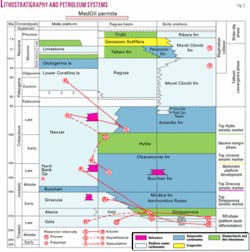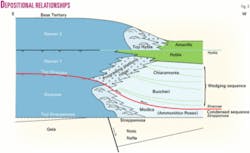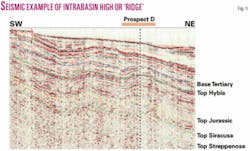Intrabasin ridge trend offers new possibilities off Malta
Recent work by MedOil PLC and its technical advisor Exploration Consultants Ltd. has identified a new play in the Mediterranean Sea off northwestern Malta, and the area has the potential to become a major hydrocarbon province.
As outlined below, all the key geological elements are present. Further the region can be said to be the southern extension of the oil producing Ragusa basin in onshore and offshore southern Sicily (Fig. 1).
Past oil exploration in Malta has been disappointing from the initial effort of BP/D’Arcy in the 1950s to an ENI SpA well in 2002.
Through the evaluation of over 5,600 km of seismic profiles and information from six exploration wells, we conclude that the area can be segregated into two geologically distinct provinces. These are a carbonate platform and a clearly recognized basin area.
All of the exploration wells were drilled on the carbonate platform. In the basin are important intrabasin “highs” or ridges where optimal reservoir development and trap formation can be expected. These intrabasinal ridges have not been drilled thus far in Maltese territory.
The intrabasin ridge trend therefore offers a new and highly prospective oil play in Malta, and several large seismically defined structural prospects and leads have been identified in this basin setting.
Regional geology
The study area lies on the Pelagian Block, a stable continental crustal block that extends from North Africa to Sicily.1 It is bounded on the west by the Maghrebian fold/thrust belt, to the north by the Calabrian forearc, and to the east by the Malta escarpment and the oceanic crust and accretionary terrane of the Ionian Abyssal Plain.
Malta platform
The Malta platform extends northwards through eastern Sicily towards the Maghrebian thrust front.
It is bounded to the east by the Malta escarpment and to the west by the Ragusa basin and Gela foredeep basin. The platform has formed a positive area to the east of the Maltese Islands since the Late Triassic as an elevated part of the Pelagian Block.2
Ragusa basin
The Ragusa basin forms the relatively depressed part of the Pelagian Block.
It extends from Sicily towards Malta and is characterized by the occurrence of the basinal kerogen-rich Noto and Streppenosa formations. It is bounded to the south by the Gozo-Malta Strike-Slip Zone, to the west by the Gela basin, and to the east by the Malta platform.
Several extensional faults cut the basin running in a NE-SW direction extending from onshore Sicily towards Malta. These are dated as possibly Triassic in age. The Sicili-Ragusa-Irmino Line, a dextral strike-slip fault system, runs across the basin in a NNE-SSW direction.
Tectonostratigraphy
The basin and platform relationship was probably initiated during the Triassic-Early Jurassic (Fig. 2).
This phase marks the initiation of continental breakup in this part of the Mediterranean. It is thought to have been associated with regional strike-slip movements linking Tethyan opening in the east with Central Atlantic formation in the west.
It was responsible for the platform-to-basin differentiation that characterizes the region even into the postrift development. This is exemplified in the MedOil area by the Malta platform and the Ragusa basin.
The Sicili-Ragusa-Irmino Line also became established at this time as a dextral strike-slip fault system. A series of NE-SW strike-slip and extensional faults is seen onshore Sicily. These faults are interpreted to extend southwards through the Ragusa basin. They are thought to have played a role in controlling the development of intrabasin highs.
Seismostratigraphy
The interpretation focused on the interval between the Top Streppenosa and Base Tertiary seismic horizons (i.e., Lower Jurassic to Upper Cretaceous) and encompassing the Top Siracusa (top Lower Jurassic) and Top Hybla (Mid Cretaceous) seismic markers (Fig. 3).
This depicts the platform-to-basin relationships across the main Malta platform edge into the Ragusa basin. The wells drilled in Maltese territory have only penetrated the platform carbonate sequences, which has meant that our understanding of the basinal section is based on exploration from wells in Sicily.
The Top Streppenosa to Top Siracusa interval depicts a relatively thick platform sequence thinning in a ramp-like fashion into the basin. Internal stratal relationships cannot be discerned, but the Ammonitico Rosso is interpreted as a condensed sequence in the basin and may therefore represent a maximum flood event in seismic stratigraphic terms. In this way at least the upper part of the basinal Modica sequence is interpreted as a transgressive systems tract. On the platform the Top Siracusa may represent the transgressive surface.
The Top Siracusa to Top Hybla interval depicts a thickening sequence into the basin. This thickening is explained on the seismic by a basinward divergence of reflectors in the “wedging sequence” (Fig. 3). The platform edge (Naxxar 1 platform sequence) advanced into the basin through time, i.e., is aggradational to progradational, and is thus interpreted as representing deposition in highstand conditions.
The overall platform-to-basin morphology in this case appears to be a “bank” setting. The wedging nature of the basinal sequences can be explained as either rapid pelagic sedimentation in a subsiding basin with some external clastic contribution or by platform development being interpreted by rapid sea-level falls and the intermittent contribution of debris flows and lowstand deposits into the basin.
Stratal relationships are difficult to depict in the upper part of the interval, but the Hybla formation is depicted as a transgressive systems tract. This therefore culminates in the Cenomanian-Turonian flooding of the platform and corresponds to the oceanic anoxic event (OAE-2) recognized extensively in North Africa.3
This presupposes that somewhere near the base of the Hybla or perhaps in the Chiaramonte formation there is the representative of a lowstand systems tract. This may explain the basinward wedging in the upper part of the interval. In this case the Top Hybla horizon probably relates to a type I unconformity (sequence boundary) on the platform but a maximum flooding surface (downlap surface) in the basin.
The Top Hybla to Base Tertiary interval displays basinward thinning. The Top Hybla is only observed from the platform margin into the basin, but the Base Tertiary is a strong event that clearly shows the ramp-style morphology (Fig. 3). The interval is interpreted as aggradational or progradational in a highstand systems tract.
Intrabasinal “highs” or ridges have been observed on seismic data and mapped with the help of isopachs. These are thought to be analogous to the intrabasinal highs recognized onshore and off Sicily4 and important in terms of controlling the development of reservoirs and the location of oil fields.
Petroleum geology
The proximity of the MedOil permits and similarities in geology to the producing basins of Tunisia and Sicily gives encouragement to the occurrence of active petroleum systems in the area.
Seismic interpretation suggests that the Ragusa basin may extend into the northwest part of the MedOil ESA, making it likely that analogs of Sicily’s producing fields (Vega, Mila, Ragusa, and Irminio) are present.
Source rocks
Source rocks recognized onshore Sicily and in the Ragusa basin north of the study area include intervals in the deep marine Noto and Streppenosa formations.
The Noto formation is dominated type I-II kerogens and is therefore oil prone. The Streppenosa formation is dominated by type III kerogens indicating it is terrestrially derived organic material and more gas prone.
Both of these source intervals are predicted to occur in the study area. Source potential has also been recognized in the Hybla formation5 equivalent to the oceanic anoxic event responsible for deposition of the organic rich shales of the Bahloul and Zebbag formations of eastern Tunisia.3
This interval has been analysed onshore Sicily and comprises cherty mudstones and shales with recorded TOC values up to 26%.5 The Hybla formation source rocks are predicted in the study area.
Reservoirs
The principal reservoirs in the Ragusa basin of Sicily are the Upper Triassic Gela formation dolomites and the Middle Jurassic Siracusa formation limestones.
The Gela formation is producing at Prezioso, Gela, and Ragusa fields. The Alexia-2 well in the study area also reported moderate porosities in the dolomites and dolomitic limestone of this interval.
The Siracusa limestone is on production at Vega and Cammarata-Pozillo fields. The limestone was deposited as reefal carbonates that have been partially dolomitized. Both horizons are predicted to be widespread in the study area.
The proven reservoirs of Sicily oil fields are extrapolated into the study area particularly in association with platform edge and intrabasinal ridge locations where biohermal or shoal buildups can be expected. Results from wells drilled in the study area also allow interpretation of potential reservoirs in the carbonates of the Lower Coralline and Naxxar formations (Fig. 2).
Petroleum systems
The discoveries in the Triassic and Jurassic of the Ragusa basin are predominantly attributed to the Streppenosa and Noto formation source rock intervals.
The Streppenosa shales are the source rocks for Mila, Irmino, Prezioso, Gela, Ragusa, and Vega fields. It is hypothesized that this interval would also be able to source a Naxxar Group reservoir.
The Cretaceous Hybla formation is predicted to source reservoirs shallower in the section. Catania and Cisina gas fields in the Gela foredeep are producing from Pleistocene sandstones that are thought to be sourced by interbedded argillites.2
Play types
Plays have been conceptualized on a regional basis by considering the prospective reservoir/seal intervals developed regionally and in the study area with an appropriate source rock.
Potential trapping configurations are considered for each play to derive play/trap combinations (Fig. 4). These include already established reservoir/trap combinations in producing fields and completely conceptual situations based on the structural and stratigraphic interpretation of our study.
Play/trap types have been identified as follows:
1. Faulted structures. These occur to the south and west of the study area over Malta and the Lampuko high and in the Gozo-Malta Strike-Slip Zone. Structures have therefore been formed by strike-slip faulting, which means that there is a high seal risk due to the through going nature of the “late” (Mio-Pliocene) faulting.
2. Intraplatform highs. These occur over the main platform area in the east of the study area. This area is relatively unaffected by faulting, but the “structures” could be flexurally formed (over deeper structure) or by depositional mounding. Of numerous wells drilled in this area that tested this play/trap type, none has encountered hydrocarbons, source rocks, or substantial intervals with good reservoir properties.
3. Platform edge buildups. The geological model presented in this study has shown that the main carbonate platform lies south and east of the study area and strikes north-eastwards towards Sicily. The transition between platform and basin becomes difficult to map as the platform enters the Gozo-Malta Strike-Slip Zone. The location of the platform edge has been mapped with the help of isopachs. It is anticipated that biohermal or shoal buildups may have developed in this setting providing good reservoir potential. No well has been drilled in this zone, but neither of the closest wells, Valletta-1 and MS-B1, penetrated a source rock or encountered an effective seal or reservoir. This play/trap combination has therefore not been properly tested off Malta.
4. Intrabasinal “highs” or ridges. This is a proven play/trap combination, with the producing fields of Vega, Gela, Ponte Drillo, and Cammarata-Possillo, located on intrabasinal highs.4 Reservoirs occur in the Siracusa and Gela formations as biohermal or shoal buildups. Source rocks occur in the flanking shales of the basinal Streppenosa and Hybla formations. Prospect “D” is a good example (Fig. 5).
Exploration outlook
The intrabasin ridge trend therefore offers a new and highly prospective oil play in Malta. Of the recognized play types over 20 prospects and leads have been identified.
• In the Ragusa basin are important intrabasin “highs” or ridges where optimal reservoir development and trap formation can be expected.
• Established plays associated with known petroleum systems and producing oil fields in southern onshore and offshore Sicily can be confidently extrapolated into Area 3, Blocks 2 and 3, and in the Ragusa ridge trends.
• These intrabasinal ridges have not been drilled thus far in Maltese territory.
• Areal size and structural closure of the identified intrabasin highs indicate potential reward in the billion barrel class.
• Better quality seismic data are required to progress our technical understanding of the play.
Acknowledgments
The new play concept was conceived by MedOil and refined and consolidated by the ECL project team of Steve Lawrence as chief geologist, Rachel Kieft, and Richard Wanstall. ✦
References
1. Bishop, W.F., and Debono, G., “The Hydrocarbon Geology of Southern Offshore Malta and Surrounding Regions,” Journal of Petroleum Geology, Vol. 19, No. 2, 1996, pp. 129-160.
2. Granath, J.W., and Casero, P., “Tectonic Setting of the petroleum systems of Sicily,” in Swennen, R., Roure, F., and Granath, J.W., eds., “Deformation, fluid flow, and reservoir appraisal in foreland fold and thrust belts,” AAPG Hedberg Series No. 1, 2004, pp. 391-411.
3. Luning, S., et al., “Integrated depositional model of the Cenomanian-Turonian organic-rich strata in North Africa,” Earth Science Reviews, Vol. 64, 2003, pp. 51-117.
4. Pedley, H.M., “Syndepositional tectonics affecting the Cenozoic and Mesozoic deposition in the Malta and SE Sicily areas (Central Mediterranean) and their bearing on Mesozoic reservoir development in the N. Malta offshore region,” Marine and Petroleum Geology, Vol. 7, 1989, pp. 171-180.
5. Scopelliti, G., et al., “High-resolution geochemical and biotic records of the Tethyan ‘Bonarelli Level’ (OAE2, latest Cenomanian) from the Calabianca-Guidaloca composite section, northwestern Sicily, Italy,” Palaeogeography, Palaeoclimatology, Palaeoecology, Vol. 208, Nos. 3-4, 2004, pp. 293-317.
The author
David M. Thomas ([email protected]) is chief executive officer of MedOil PLC. He is a geologist with 30 years’ experience in the oil and gas industry, mainly in North and West Africa. He was with Occidental Petroleum Corp. in Libya, Tenneco Oil Co. in Tunisia, and was international chief geologist for Kuwait Petroleum Corp. He has a BSc in geology and chemistry from the University of London.






